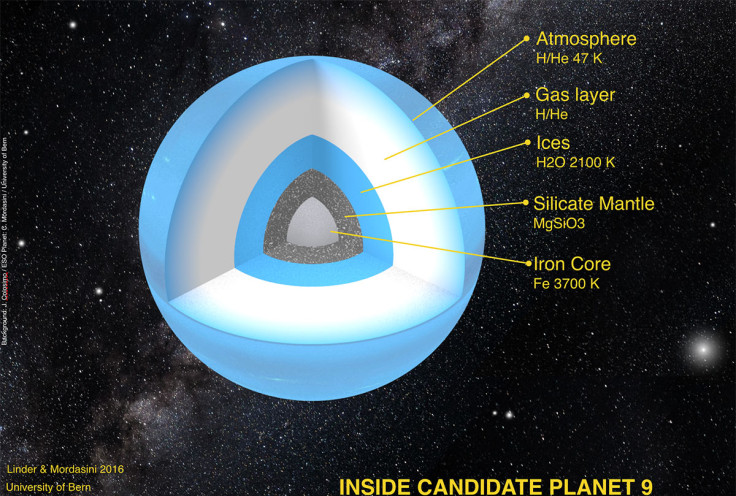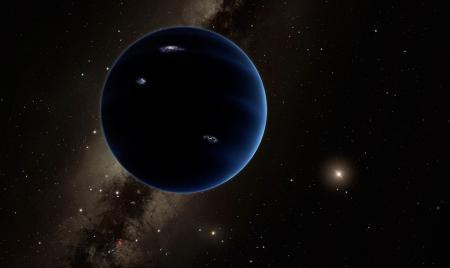A world of ice and iron stolen by the Sun? What we learnt about Planet 9 in 2016
Caltech scientists claimed to have evidence indicating the presence of a giant planet at edge of solar system in January.
At the start of the year, scientists at Caltech announced they had found evidence to indicate a giant planet was lurking at the outer edge of the solar system. Dubbed Planet Nine, the team had noticed a group of objects with extremely unusual orbits. These orbits, the team said, could be explained by the presence of a massive planet dominating the gravity in the region of space these objects are found.
While astronomers are working to prove Planet Nine's existence, scientists have learned a lot about this hypothetical planet. Here are some of the most interesting findings from the past year.
It is made from iron and ice

Astrophysicists modelled the evolution of Planet Nine to work out what it might be like. The team, from the University of Bern, assumed the planet is a smaller version of Uranus and Neptune and calculated how certain parameters would have changed since our solar system formed.
Their findings indicate the planet has a mass equal to 10 Earths, has a radius of 3.7 Earth radii and a temperature of minus 226C. It would have an iron core, silicate mantle and a water ice shell. "With our study candidate Planet 9 is now more than a simple point mass, it takes shape having physical properties," said Christoph Mordasini, one of the authors of the study, which is published in Astronomy & Astrophysics.
Our sun 'stole' it from another solar system
Researchers from Lund University in Sweden carried out computer simulations to try to work out how (if it exists) Planet Nine ended up orbiting the Sun at such a great distance (an estimated 700AU, although its orbit is tilted). Models indicate the most likely scenario is that the planet was stolen from another solar system.
They found the planet – in its infancy – may have been born into another solar system. Stars are born in groups, so when they are young, solar systems regularly pass by each other. As Planet Nine passed by our solar system, the Sun's gravitational pull on it was stronger than that of its own star. As a result, Planet Nine was torn away and set onto its current orbit. Findings are published in the Monthly Notices of the Royal Astronomical Society Letters.
It's not alone – more planets hiding at the edge of the solar system
There may be more even planets hiding at the edge of the solar system. Writing in the Monthly Notices of the Royal Astronomical Society, a team of scientists looked at the orbits of six objects thought to be being influenced by Planet Nine. While three remain stable, the others should have become highly unstable after around 12 million years, eventually leading to them being ejected from the solar system.
But that did not happen. The presence of additional unknown planets would, however, account for this. "We believe that, in addition to a Planet Nine, there could also be a Planet 10 and even more," said study author Carlos de la Fuente Marcos.
Concluding, the team wrote: "Is Planet Nine alone or are there more? Planet Nine, if it exists, moves in an elongated orbit that may be vulnerable to long-term secular perturbations resulting from the Galactic tide or discrete events like close encounters with passing stars. In this context, a lone Planet Nine may not be able to survive in its present orbit for the age of the Solar System, but a planet within a planetary group has better chances to be long-term stable. Therefore, if Planet Nine exists, it is probably not alone."
Planet 9 will kill Jupiter, Saturn, Uranus or Neptune

When the Sun dies in seven billion years, Planet Nine could destroy at least one of the gas giants. Astrophysicist Dimitri Veras found that under certain conditions the planet could get dragged into the middle of the solar system. When the Sun dies, it will expand, consuming the planets closest to it. Jupiter, Saturn, Uranus are Neptune, however, will be safe.
In his study, which appears on the pre-print server arxiv.org, Veras showed that if Planet Nine is massive enough and has an orbit at a certain distance, the expansion of the Sun will cause it to be pulled in. This will create a pinball effect for the other planets, pushing at least one of them out of the solar system to face a violent death.
Veras said: "The existence of a distant massive planet could fundamentally change the fate of the solar system. Uranus and Neptune in particular may no longer be safe from the death throes of the Sun."
Planet Nine explains the Sun's weird tilt
The weird orbit of Planet Nine could help explain why the Sun appears to be tilted. Scientists from Caltech looked at the objects orbiting the planet to discover it sits on an angle of around 30 degrees compared to all of the other planets. All of the other planets orbit the Sun within a few degrees of each other along a flat plane. But this plane is at a six degree tilt to the Sun, which makes the star look like it sits on an angle. Until now, no one knew why this was.
However, if Planet Nine does exist, it would explain this unusual tilt – its angular momentum would produce a force on the rest of the solar system. "Because Planet 9 is so massive and has an orbit tilted compared to the other planets, the solar system has no choice but to slowly twist out of alignment," said Elizabeth Bailey, lead author of the study set to appear in the Astrophysical Journal.
© Copyright IBTimes 2025. All rights reserved.






















